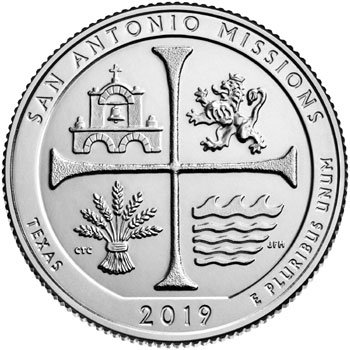
The San Antonio Missions National Historical Park Quarter was the forty-ninth overall release within the America the Beautiful Quarters Program. The site represents the state of Texas and was federally designated on November 10, 1978.
The reverse design depicts elements of the Spanish Colonial Real coin to pay tribute to the missions. Within the quadrants are wheat to symbolize farming, arches and a bell to symbolize community, a lion to represent Spanish cultural heritage, and water to symbolize the San Antonio River. The inscriptions read “San Antonio Missions”, “Texas”, “2019”, and “E Pluribus Unum”. The reverse was designed by United States Mint Artistic Infusion Program Designer Chris Costello and sculpted by Joseph Menna.
The San Antonio Missions Quarter was officially released for circulation on February 4, 2019. The Denver Mint struck 129,400,000 and the Philadelphia Mint struck 142,800,000 coins for circulation. The West Point Mint also struck 2,000,000 coins for release into circulation in order to inspire interest in coin collecting.
San Antonio Missions Quarter Mintages
- 2019-D San Antonio Missions Quarter: 129,400,000
- 2019-P San Antonio Missions Quarter: 142,800,000
- 2019-W San Antonio Missions Quarter: 2,000,000
San Antonio Missions Quarter Specifications
- Designers: John Flanagan (obverse), Chris Costello (reverse)
- Composition: 91.67% copper, 8.33% nickel (clad), 90% silver, 10% copper (silver proof)
- Diameter: 24.26 mm
- Weight: 5.67 grams
- Thickness: 1.75 mm
- Edge: Reeded
About San Antonio Missions National Historical Park
Although European settlers are responsible for being the ones to develop some of the first towns and businesses in the early days of the United States, it was Spaniards and the French that are credited with helping to map, settle and explore much of the Southwest. It was only 1718 when the first Franciscans and Spanish chose to develop their first missionary outpost in what would eventually become the state of Texas, and more specifically, the city of San Antonio. These missionaries sought to bring the theology of the Christian religion to the native peoples that already inhabited these areas, in order to make them more civilized.
The San Antonio Missions National Historical Park was officially recognized as having historical significance by the federal government in November of 1978. As such, the buildings and structures of the missionaries have been well preserved, creating a unique experience for visitors to this national park. When you visit this historical park, you are welcomed to place yourselves in the shoes of these early missionaries, who risked everything to set up a place in a new country in order to save the souls of a people they considered to be savage. Park visitors might even get a chance to talk with people that are actual descendants of the Franciscans and Spanish. In addition to being spiritual advisors, the monks had to survive, so they also had to be ranchers and farmers as well. There was no room on the Texas frontier for the weak or the faint of heart.

